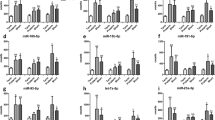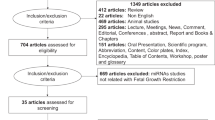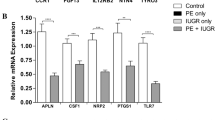Abstract
We investigated candidate gene and microRNA (miRNA) expression in amnion and chorion in relation to risk of preterm delivery (PTD). Amnion and chorion were separated from placenta and collected at delivery from participants who delivered at term (N = 10) and from participants who delivered preterm following spontaneous labor (sPTL-PTD; N = 10), premature rupture of membranes (PPROM-PTD; N = 10), and preeclampsia (PE-PTD; N = 10). Expression of genes (metalloproteinase [MMP] 2, MMP-9, and tissue inhibitors of MMP-1) and miRNAs (miR-199a*, -202*, -210, -214, -223, and -338) was profiled using quantitative real-time polymerase chain reaction approaches. Adjusted multinomial logistic regression models were used to calculate relative risk ratios (RRR), 95% confidence intervals, and P values. Among controls, the expression of miR-199a*, -202*, and -214 was lower in the amnion compared with their expression in the chorion, whereas the expression of miR-210 was higher in the amnion compared with its expression in the chorion (all P values < .05). In the amnion, MMP-9 expression was associated with PTD risk (overall P value = .0092), and MMP-9 expression was positively associated with the risk of PPROM-PTD (RRR: 31.10) and inversely associated with the risk of PE-PTD (RRR:6.55e-6), although individual associations were not statistically significant. In addition, in the amnion, the expression of miR-210 (RRR: 0.45; overall P value = .0039) was inversely associated with the risk of PE-PTD, and miR-223 was inversely associated with all subtypes of PTD (overall P value = .0400). The amnion and chorion differ in their miRNA expression. The expression of MMP-9, miR-210, and -223 in the amnion is associated with PTD risk.
Similar content being viewed by others
References
Nhan-Chang CL, Romero R, Tarca AL, et al. Characterization of the transcriptome of chorioamniotic membranes at the site of rupture in spontaneous labor at term. Am J Obstet Gynecol. 2010; 202(5):462.e1–e41.
Li W, Alfaidy N, Challis JR. Expression of extracellular matrix metalloproteinase inducer in human placenta and fetal membranes at term labor. J Clin Endocrinol Metab. 2004;89(6): 2897–2904.
Romero R, Chaiworapongsa T, Espinoza J, et al. Fetal plasma MMP-9 concentrations are elevated in preterm premature rupture of the membranes. Am J Obstet Gynecol. 2002;187(5):1125–1130.
Demir-Weusten AY, Seval Y, Kaufmann P, Demir R, Yucel G, Huppertz B. Matrix metalloproteinases-2, -3 and -9 in human term placenta. Acta Histochem. 2007;109(5):403–412.
Riley SC, Leask R, Denison FC, Wisely K, Calder AA, Howe DC. Secretion of tissue inhibitors of matrix metalloproteinases by human fetal membranes, decidua and placenta at parturition. J Endocrinol. 1999;162(3):351–359.
Xu P, Alfaidy N, Challis JR. Expression of matrix metalloproteinase (MMP)-2 and MMP-9 in human placenta and fetal membranes in relation to preterm and term labor. J Clin Endocrinol Metab. 2002;87(3):1353–1361.
Vettraino IM, Roby J, Tolley T, Parks WC. Collagenase-I, stromelysin-I, and matrilysin are expressed within the placenta during multiple stages of human pregnancy. Placenta. 1996; 17(8):557–563.
Zhang C. MicroRNomics: a newly emerging approach for disease biology. Physiol Genomics. 2008;33(2):139–147.
Urbich C, Kuehbacher A, Dimmeler S. Role of microRNAs in vascular diseases, inflammation, and angiogenesis. Cardiovasc Res. 2008;79(4):581–588.
Bartell DP. MicroRNAs: genomics biogenesis, mechanism and function. Cell. 2004;116(2):281–297.
Enquobahrie DA, Abetew DF, Sorensen TK, Willoughby D, Chidambaram K, Williams MA. Placental microRNA expression in pregnancies complicated by preeclampsia. Am J Obstet Gynecol. 2011;204(2):178.e12–e21.
Pineles BL, Romero R, Montenegro D, et al. Distinct subsets of microRNAs are expressed differentially in the human placentas of patients with preeclampsia. Am J Obstet Gynecol. 2007; 196(3):261.e1–e6.
Montenegro D, Romero R, Pineles BL, et al. Differential expression of microRNAs with progression of gestation and inflammation in the human chorioamniotic membranes. Am J Obstet Gynecol. 2007;197(3):289.e1–e6.
Montenegro D, Romero R, Kim SS, et al. Expression patterns of microRNAs in the chorioamniotic membranes: a role for microRNAs in human pregnancy and parturition. J Pathol. 2009; 217(1):113–121.
Stata Annotated Output. Multinomial Regression. Institute for Digital Research and Education, UCLA: Statistical Consulting Group. Web site. http://www.ats.ucla.edu/stat/stata/output/stata_mlogit_output.htm. Accessed July 18, 2015.
Nishihara S, Someya A, Yonemoto H, et al. Evaluation of the expression and enzyme activity of matrix metalloproteinase-7 in fetal membranes during premature rupture of membranes at term in humans. Reprod Sci. 2008;15(2):156–165.
Plouzek CA, Leslie KK, Stephens JK, Chou JY. Differential gene expression in the amnion, chorion, and trophoblast of the human placenta. Placenta. 1993;14(3):277–285.
Yonemoto H, Young CB, Ross JT, Guilbert LL, Fairclough RJ, Olson DM. Changes in matrix metalloproteinase (MMP)-2 and MMP-9 in the fetal amnion and chorion during gestation and at term and preterm labor. Placenta. 2006;27(6– 7):669–677.
Weiss A, Goldman S, Shalev E. The matrix metalloproteinases (MMPS) in the decidua and fetal membranes. Front Biosci. 2007;12:649–659.
Eckmann-Scholz C, Bens S, Kolarova J, et al. DNA-methylation profiling of fetal tissues reveals marked epigenetic differences between chorionic and amniotic samples. PLoS One. 2012; 7(6):e39014.
Vadillo-Ortega F, Sadowsky DW, Haluska GJ, et al. Identification of matrix metalloproteinase-9 in amniotic fluid and amniochorion in spontaneous labor and after experimental intrauterine infection or interleukin-1 beta infusion in pregnant rhesus monkeys. Am J Obstet Gynecol. 2002;186(1):128–138.
Oger S, Méhats C, Dallot E, Cabrol D, Leroy MJ. Evidence for a role of phosphodiesterase 4 in lipopolysaccharide-stimulated prostaglandin E2 production and matrix metalloproteinase-9 activity in human amniochorionic membranes. J Immunol. 2005;174(12):8082–8089.
Moore RM, Mansour JM, Redline RW, Mercer BM, Moore JJ. The physiology of fetal membrane rupture: insight gained from the determination of physical properties. Placenta. 2006; 27(11–12):1037–1051.
Mayor-Lynn K, Toloubeydokhti T, Cruz AC, Chegini N. Expression profile of microRNAs and mRNAs in human placentas from pregnancies complicated by preeclampsia and preterm labor. Reprod Sci. 2011;18(1):46–56.
Zhu JY, Pang ZJ, Yu YH. Regulation of trophoblast invasion: the role of matrix metalloproteinases. Rev Obstet Gynecol. 2012;5(3–4):e137–e143.
Palei AC, Sandrim VC, Amaral LM, et al. Association between matrix metalloproteinase (MMP)-2 polymorphisms and MMP-2 levels in hypertensive disorders of pregnancy. Exp Mol Pathol. 2012;92(2):217–221.
Gomez DE, Alonso DF, Yoshiji H, Thorgeirsson UP. Tissue inhibitors of metalloproteinases: structure, regulation and biological functions. Eur J Cell Biol. 1997;74(2):111–122.
Fortunato SJ, Menon R, Lombardi SJ. MMP/TIMP imbalance in amniotic fluid during PROM: an indirect support for endogenous pathway to membrane rupture. J Perinat Med. 1999;27(5): 362–368.
Montagnana M, Lippi G, Albiero A, et al. Evaluation of metalloproteinases 2 and 9 and their inhibitors in physiologic and preeclamptic pregnancy. J Clin Lab Anal. 2009;23(2):88–92.
Kim SY, Romero R, Tarca AL, et al. miR-143 regulation of prostaglandin-endoperoxidase synthase 2 in the amnion: implications for human parturition at term. PLoS One. 2011;6(9):e24131.
Zhu XM, Han T, Sargent IL, Yin GW, Yao YQ. Differential expression profile of microRNAs in human placentas from preeclamptic pregnancies vs normal pregnancies. Am J Obstet Gynecol. 2009;200(6):661. e1–e7.
Fasanaro P, Greco S, Lorenzi M, et al. An integrated approach for experimental target identification of hypoxia-induced miR-210. J Biol Chem. 2009;284(50):35134–35143.
Corn PG. Hypoxic regulation of miR-210: shrinking targets expand HIF-1’s influence. Cancer Biol Ther. 2008;7(2):265–267.
Haneklaus M, Gerlic M, O’Neill LA, Masters SL. miR-223: infection, inflammation and cancer. J Intern Med. 2013;274(3): 215–226.
Timms PM, Mannan N, Hitman GA, et al. Circulating MMP9, vitamin D and variation in the TIMP-1 response with VDR genotype: mechanisms for inflammatory damage in chronic disorders? QJM. 2002;95(12):787–796.
Author information
Authors and Affiliations
Corresponding author
Rights and permissions
About this article
Cite this article
Enquobahrie, D.A., Hensley, M., Qiu, C. et al. Candidate Gene and MicroRNA Expression in Fetal Membranes and Preterm Delivery Risk. Reprod. Sci. 23, 731–737 (2016). https://doi.org/10.1177/1933719115612925
Published:
Issue Date:
DOI: https://doi.org/10.1177/1933719115612925




